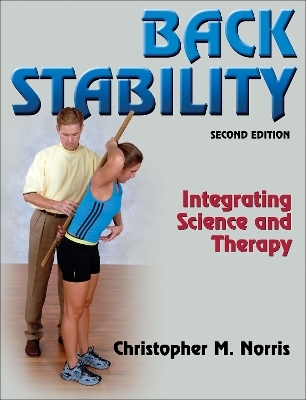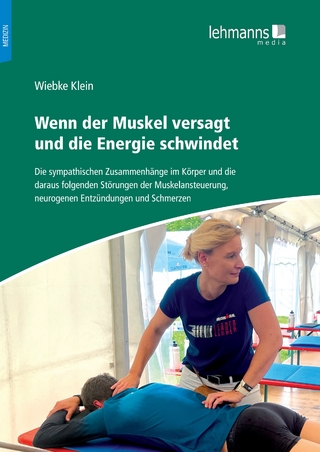
Back Stability
Human Kinetics (Verlag)
978-0-7360-7017-1 (ISBN)
- Titel ist leider vergriffen;
keine Neuauflage - Artikel merken
Back Stability: Integrating Science and Therapy, Second Edition, is designed to help practitioners recognize and manage back conditions using proven clinical approaches to stabilize the spine. More than just another sequence of back exercises, this text provides a theoretical foundation that will guide you in selecting the most effective exercises for each client and integrating them into a complete program to offer the best possible care in back health.
A focus on evidence-based practice pervades Back Stability to address one of the most common maladies of modern living: back pain. This text combines research from around the world in the areas of anatomy, physiology, pathology, biomechanics, exercise physiology, and motor skill training with the practical knowledge of author Christopher Norris, a physiotherapist, exercise professional, and teacher for more than 30 years. With his expertise, you will gain the practical knowledge to help you recognize and assess inappropriate movement patterns—whether caused by injury or simple day-to-day activity—and use a process of clinical decision making to determine which exercises to use in developing effective back care programs.
In addition to updated research, the second edition has undergone many changes that improve the book's layout and make it more user friendly:
-The 33 new exercises as well as modified versions of previous exercises help refine and customize each program.
-Detailed teaching elements throughout the book provide constructive and motivating ways to prescribe exercises to clients and patients.
-Photographs clearly demonstrate each exercise technique and, where appropriate, are overlayed with arrows or lines to show proper body alignment.
-A second color is integrated throughout the text, enhancing the visual flow.
-Bullet points summarize and facilitate quick reference of exercise technique, and checklists aid in exercise prescription.
-A larger format for the text allows for a more attractive presentation with bigger photos and easier recognition of important information.
The second edition of Back Stability is organized into five parts that follow a logical progression from initial concepts to clinical applications. The text introduces the problems of back pain and instability and provides an explanation of spinal anatomy, movements, and the physics of lifting. A discussion follows of the basic skills required for developing stability. Assessments of posture and muscle balance are highlighted, and foundational movements for development of core stability are introduced.
After covering the basics, the text moves into more practical applications by presenting progressive exercises and basic equipment used for developing greater stability. Information on abdominal training, resistance apparatus, speed and power, and practical functional progressions will help your patients or clients increase back stability and enhance performance. Finally, real-life patient examples illustrate how to structure a full back stability program.
Back Stability: Integrating Science and Therapy, Second Edition, presents an alternative method for the treatment of back pain and provides each patient or client the opportunity to actively participate in recovery and maintenance. By integrating the science behind back pain into a useable format for understanding and application, Back Stability offers proven methods of care and assists your work with clients and patients to alleviate their pain, increase their back stability, and help them return to a fully functional lifestyle.
Christopher M. Norris, PhD, is a physiotherapist and director of Norris Associates, which operates two private clinics in northwestern England that specialize in exercise therapy for back rehabilitation. Norris is also a consultant to several Blue Chip industries in northwestern England providing on-site physiotherapy services, on-site holistic therapy, training in ergonomics, and training in manual handling. In addition to more than 30 years of clinical experience, Norris has served as a postgraduate lecturer in the United Kingdom and Europe and as an external examiner and visiting lecturer for several universities in the United Kingdom. He serves on the board of directors of the International Sports and Spine Society and on the international advisory board (IAB) for the Journal of Bodywork Movement Therapies. He is a former IAB member of Physical Therapy in Sport and Sport Exercise and Injury. Norris resides in Congleton in the Cheshire region of England. In his free time he enjoys coaching and practicing ju jitsu, running in the Cheshire countryside, and hill walking in the Peak National Park.
Part I. Conceptual Foundation
Chapter 1. What Is Back Stability
Scope of the Problem
A New Look at the Etiology and Treatment of Back Pain
Model Used in This Book: Lumbar Stabilization
Summary
Chapter 2. Biomechanics of the Lumbar Spine
Anatomy of the Vertebral Column
Axial Compression
Movements of the Lumbar Spine and Pelvis
The Mechanics of Bending and Lifting
Lifting Methods
Summary
Chapter 3. Stabilization Mechanisms of the Lumbar Spine
Posterior Ligamentous System
Thoracolumbar Fascia
Trunk Muscle Action
Intra-Abdominal Pressure Mechanism
Summary
Chapter 4. Principles of Muscle Imbalance
Basic Concepts
Muscle Adaptation to Increased and Decreased Usage
Training Specificity
Changes in Muscle Length
Summary
Part II. Establishing Stability
Chapter 5. Posture
Optimal Postural Alignment
Postural Stability and Body Sway
Basic Postural Assessment
Principles of Postural Correction
Posture Types and How to Correct Them
Summary
Chapter 6. Muscle Balance Tests
Assessing Stretched Muscles—Testing Inner-Range Holding Ability
Assessing Shortened Muscles
Principles of Muscle Stretching
Stretching Target Muscles
Assessing Segmental Control
Summary
Chapter 7. Foundation Movements
Teaching Your Clients to Control Pelvic Tilt
Teaching Your Clients to Identify and Assume the Neutral Position
Teaching Your Clients to Use Abdominal Hollowing
Teaching Your Clients to Contract the Multifidus Muscles at Will
Summary
Part III. Progressing Stability Training
Chapter 8. Limb Loading
Superimposed Limb Movements
Summary
Chapter 9. Unstable Base
Theory of Proprioception
Benefits of Training
Summary
Chapter 10. Gym Ball
Gym Ball Exercises
Summary
Chapter 11. Foam Rollers
Principles
Summary
Part IV. Building Back Fitness
Chapter 12. Faults With Traditional Abdominal Training
Sit-Up
Straight-Leg Raise
Potentially Dangerous Exercises
Summary
Chapter 13. Abdominal Training Using Stability Concepts
Modifications of the Sit-Up
Modifications of the Straight-Leg Raise (SLR)
Ab Roller Exercises
Testing Midsection Muscle Endurance
Summary
Chapter 14. Resistance Training for Core Strength
Weight Training
Summary
Chapter 15. Speed and Power in Core Training
Theory of Power Through Speed Training
Summary
Chapter 16. Functional Training
Movement Analysis
Movement Components
Lifting Techniques
Summary
Part V. Clinical Application
Chapter 17. Preliminary Client Assessment
Assessing Pain
Assessing Disability
Summary
Chapter 18. Designing the Program
Needs Analysis
Program Aims
Training Plan
Principles for Designing a Stability Program
Summary
Chapter 19. Case History Illustrations
Overweight Client
Athlete With Poor Stability
Client With Acute Pain
Patient Unwilling to Exercise
Pregnant Client With Back Pain
Summary
| Erscheint lt. Verlag | 3.4.2008 |
|---|---|
| Verlagsort | Champaign, IL |
| Sprache | englisch |
| Gewicht | 1247 g |
| Themenwelt | Medizin / Pharmazie ► Medizinische Fachgebiete ► Sportmedizin |
| Medizin / Pharmazie ► Physiotherapie / Ergotherapie | |
| ISBN-10 | 0-7360-7017-6 / 0736070176 |
| ISBN-13 | 978-0-7360-7017-1 / 9780736070171 |
| Zustand | Neuware |
| Haben Sie eine Frage zum Produkt? |
aus dem Bereich


